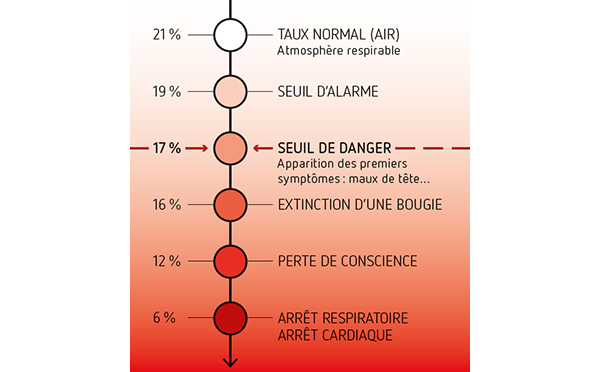"Why do some people feel particularly uncomfortable in environments where the oxygen level is slightly lowered (e.g., at 17-18 %), while most people don't seem to notice anything?", asks Michel L., a loyal reader of Science and Future, in a letter.
The air we breathe contains approximately 21 % of oxygen at sea level. But this proportion can decrease in many situations: poorly ventilated rooms where the air becomes loaded with carbon dioxide (CO2), pressurized airplane cabins at the equivalent of 2000 meters of altitude (i.e. 15 to 17 % of oxygen), smoky or very crowded areas. These variations, often subtle, go unnoticed by the majority of us: our body compensates by accelerating breathing and heart rate.
Mild hypoxia, a real stress for the body
When the oxygen content of the air falls below 19.5 % – threshold defined by OSHA (US Occupational Safety and Health Administration) – this is called an “oxygen-depleted atmosphere.” Symptoms vary: shortness of breath, feeling hot, headaches, dizziness, difficulty concentrating. At 17-18 %, these signs remain moderate but very real: the blood is less oxygenated, which forces the heart to pump harder to deliver the precious gas to the organs. Some people detect these variations faster than others, either because they are physiologically more sensitive or because they have learned to recognize weak signals (accelerated breathing, feeling of oppression).
Professional experience plays a key role here. For example, a technician trained in the use of oximeters knows how to associate their bodily sensations with specific numbers: the alarm beeps at 16 %, breathing difficulties at 17 %. This conditioning sharpens perception. It's a well-documented phenomenon: high-level athletes, for example, become more aware of their heart rate or their ventilation than the general public. Hypersensitivity is therefore not "psychological": it is a matter of increased bodily vigilance.
Heat and humidity, aggravating factors
Not to mention that heat exacerbates the problem: sweating becomes less efficient when the air is humid, the body overheats, and breathing accelerates. This hyperventilation lowers blood CO2, altering blood chemistry and amplifying the feeling of discomfort. In summer, a poorly ventilated room at 25°C can quickly become unbearable, not only due to thermal discomfort but also due to the relative oxygen deficit.
Read alsoHeatwave: Why does an apartment at 25°C seem comfortable in winter and stifling in summer?
Why doesn't everyone experience hypoxia?
Tolerance to hypoxia varies from one individual to another: age, health status (cardio-respiratory, anemia), physical condition or even genetics can influence sensitivity. Depending on theNational Institute for Research and Security (INRS), studies have shown that some people only notice the effects from 15 % of oxygen, others from 19 %. This explains why some people remain indifferent while others feel oppressed and have to go outside to get some fresh air.
This sensitivity should not be underestimated: atmospheres that are too low in oxygen can become dangerous. The INRS reminds us that below 17 %, vigilance decreases and reaction times lengthen, which can be problematic in a professional environment. Good ventilation and monitoring of air quality (CO2 sensors, oximeters) are therefore essential, especially in enclosed spaces open to the public.

Oxygen levels in the air and consequences for humans. Credits: INRS


